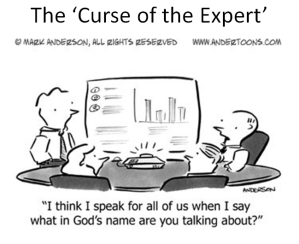The 15 minute forum tonigh was led by Andy Tharby.
Andy started by sharing 3 principles for good teacher explanation:
- New knowledge should be linked to existing knowledge
- Ideas should be introduced in clear steps
- Abstract ideas are made simple and concrete in the listener’s mind
 Good explanations matter, because it becomes very easy to fall into the curse of the expert. As highly knowledgeable subject experts, it’s very easy for us to forget the steps we took to acquire this knowledge. So we need to be tactical and strategic, whenever we are explaining new ideas, if we are going to make the information accessible to our students. Storytelling helps with this.
Good explanations matter, because it becomes very easy to fall into the curse of the expert. As highly knowledgeable subject experts, it’s very easy for us to forget the steps we took to acquire this knowledge. So we need to be tactical and strategic, whenever we are explaining new ideas, if we are going to make the information accessible to our students. Storytelling helps with this.
Why tell stories?
“Stories are ‘psychologically privileged’.” We are ‘hard-wired’ to learn from stories, as that’s how early humans learnt from their ancestors, before we had books and other methods of passing on information.
– Daniel Willingham, Why don’t students like school?
“Stories drive action through simulation (what to do) and inspiration (the motivation to do it).” If you imagine somebody tapping your shoulder, a part of your brain that would be activated if you were, becomes active.
– Chip and Dan Heath, Made to Stick
“Stories are wonderfully efficient resources: we transport them in our minds. They require no photocopying, PowerPoint slides or glue sticks.”
– Allison and Tharby, Making every lesson count
It’s worth exploring in more detail why telling stories aids teacher explanation, and then looking at how it can be done.
To make success feel tangible
How?
Tell stories of past students
e.g. “I remember this one student who was great at writing extended answers, because they always put a huge amount of effort into responding to an improvement points that I suggested. The way she did this was by …….”
Success narratives
e.g. stories of GCSE success – keep the best exercise book/ piece of work from this year, and show it to new students in September. Talk about why the student who completed that piece of work was so successful.
To highlight common misconceptions
How?
Challenge your students to avoid the mistakes of their predecessors. Share examples of student mistakes with students. Talk them through why that mistake may have been made, and how it can be avoided.
To make the abstract, concrete
How?
Find the human element – invented or real
e.g. In geography, when studying tsunamis, start with a video clip of tsunami survivors talking about their experiences, or images of the destruction caused by them.
Improvisation
e.g. utilitarianism – make up a story e.g. “If somebody was to burst into this room with a gun in their pocket, would it be right for me to attack them with a metre ruler?”
To immerse students in the rich history of your subject
How?
Tell stories about pioneers/inventors/historical greats
e.g. Tell the story of how Shakespeare bequeathed his second best bed to his wife – and then explore what this tells us about the role of women in those times.
If we restrict our teaching to mere facts, we lose the humanity of what we are teaching – and prevent students from making links.
To promote the desire to know more
How?
‘Gap theory’ – Lowenstein, 1994 – says that gaps cause ‘a kind of pain’ that we want to fill with what’s missing. So, by leaving out bits of the explanation at the start, or not telling them the ending or the solution, we leave them wanting to find out more. This is why starting a lesson with a big question can be great e.g. ‘Can we really know that the big bang happened?’
Look for mysteries, crises and conflict and use these in our storytelling.
e.g. Robert Cialdini is a psychologist, who talks about this idea. He describes an occasion when he found an article on science that gripped him. This was surprising, as he wasn’t usually interested in science, but this grabbed his attention. The article was called ‘What are the rings of Saturn made from?’. He read the whole article – because the answer wasn’t revealed until the end of the article.
A retired Durrington English teacher, Sue Wolstenholme, described the importance of effective explanations perfectly once to Andy:
“It’s about getting students to feel something as we speak”
Further reading
Teaching that Sticks’ pdf – Chip and Dan Heath – this article talks about how our explanations can be made to stick. Summary below:
It’s all about tellin’ stories:













Reblogged this on The Echo Chamber.
Reblogged this on teaching knowledge and creativity.
Thanks very much for this – as I’ve posted on Heatherf’s blog – this seems to tie in extremely well with her ‘Cause and Effect’ blog posted on the same day as yours as well as my blog from last week about ‘Remodelling the Ideal teacher’ – in particular my diagram about the value of extended teacher knowledge linked to below. Or, maybe it’s just in my head…
Actually… Heather’s blog ties neatly between the two ideas – mine doesn’t link so obviously with yours!
Pingback: Education Panorama (June ’15) by @TeacherToolkit | @TeacherToolkit
Reblogged this on Blogs of the Month.